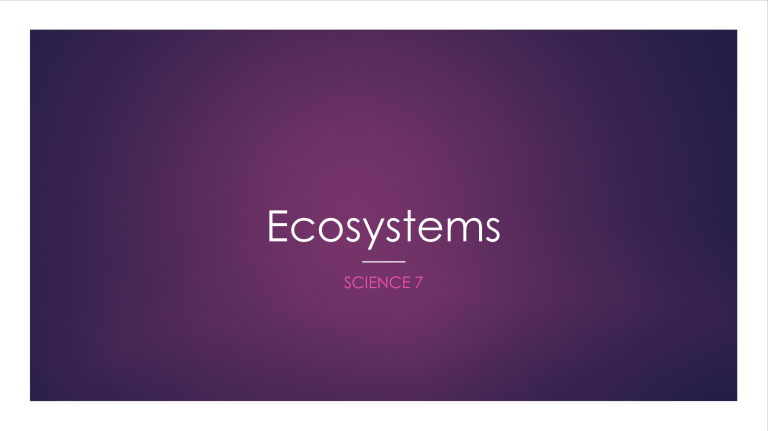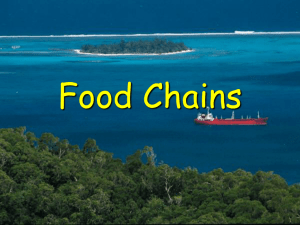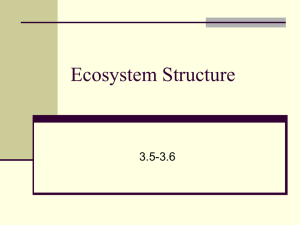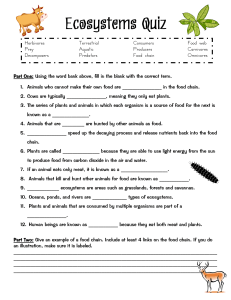
Ecosystems SCIENCE 7 Day Four Ecosystems are made up of living and non – living things. Scientifically, living and non – living is known as biotic and abiotic. Biotic: - Animals - Plants - Bacteria Abiotic: - Water - Rocks - Oxygen - Sunlight Ecosystems An ecosystem is any place where living and non – living things interact. They can be big or small. Task: List 5 different ecosystems 1. 2. 3. 4. 5. Criteria for living things There are Specific Criteria for living and non – living things: All living things are composed of one or more cells All living things are organized into complex patterns All living things use energy All living things have internal conditions that must be maintained in equiliveium (homeostasis) All living things grow and change All living things have the ability to reproduce If something does not have one of these criteria, then it is considered non – living. Note: There are some exceptions! But very few. All Living Things Need: 1 2 3 4 5 6 Need water Need energy Need food Need oxygen Need suitable living conditions Need to interact with each other and with nonliving things Day Five Review: Look at the Picture Above. What is living? What is non – living? River Walk Task: We are going to look at an ecosystem close to our school, the Saskatchewan River. In partners, note everything you see/ feel; including wind, sunshine, clouds, air temperature, etc. Record this information for three areas along the river. Food for Thought: Think what would happen if an ecosystem didn’t have the abiotic factors: wind, sunlight, soil and water. Assignment: Look at the river and shoreline and list all living and non – living parts. Then, explain what would happen if an ecosystem didn’t have abiotic factors. Hand in on Google Classroom. Day Six Using Yesterday’s Data Answer the following questions: Does the environment provide what the living things need to survive? Are there other living things in the same environment? Do the different living things interact with, rely on, or need each other in any way? Was the environment you looked at an ecosystem? https://www.youtube.com/watch?v=VEKQ37TTtZw Task: FIND A CREATION STORY ABOUT HOW THE WORLD, AND ALL LIVING THINGS, WERE CREATED! Day Seven Ecosystems are made up of Producers, Consumers, and Decomposers. Brainstorm: What category do you think the wheat field shown falls under? Producers Producers create food from the abiotic environment. This means they use non living things such as sunlight, wind, soil, and water to create food. Food is energy! Consumers Humans and other animals are consumers. Consumers depend on other living things for food. Types of Consumers Herbivores Omnivores Carnivores These are animals that only eat plants. These are animals that eat plants and other animals. These are animals that only eat other animals. Assignment: (LM1-7) USING THE HANDOUT PROVIDED, LIST DIFFERENT TYPES OF HERBIVORES, OMNIVORES, AND CARNIVORES. Day Eight Predators and Prey Predators are animals that naturally prey on other living things. Herbivores are predators of plants Wolves are predators of cattle and deer Humans are predators of almost every other living thing. Prey are living things that are eaten by predators. Plants are the prey of herbivores and omnivores Herbivores are the prey of carnivores and omnivores Walk Around Your School Pay attention to ecosystems of all sizes around your school – from as small as the anthill in the grass, to as large as the neighborhood itself. Categorize the living things as either producers, herbivores, omnivores, or carnivores. If you aren’t sure, make your best guess and we will discuss after. Day Nine Assignment Research a Saskatchewan Producer or consumer of your choice. You are creating a one page summary with the following information: Name Where it is found What it is categorized as (omnivore, carnivore, producer, etc.) What it uses for energy (food) If the plant/ animal is native to its region Its habitat Be creative! Add pictures, interesting facts, etc. Day Ten Food webs show the connections between animals within an ecosystem. They show the predators, prey, and their relationships between producers, consumers, and decomposers. Research: How is energy transferred between producers, consumers, and decomposers? Food Webs Research In your textbook, read about food webs and take notes accordingly. After you have a good understanding, create your own food web using the animals researched in class. They are as follows: Grizzly Bear Lynx Ground Squirrels White Tail Deer Skunk Feel free to add other animals in this food web, as well! Photosynthesis https://www.youtube.com/watch?v=Iln136eMl4g Photosynthesis in a nutshell Assignment: Create your own diagram of photosynthesis. Once you are done, answer the following questions: What does a plant need for photosynthesis to occur? What does a plant create that humans and other animals use?




